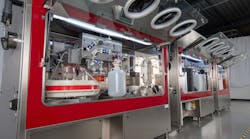There’s a new T-shirt slogan that says a lot about our current culture. It reads “Data Is the New Bacon.”
In today’s digitally savvy world, we are surrounded by a constantly mounting pile of data. Hot, sizzling data. And within the industrial/manufacturing space, the volumes of data being produced can lead to paralyzing questions:
Which is the best data to analyze in order to boost efficiency?
Which data will enable me to increase productivity?
Which data is hiding all of the extra revenue in my facility?
Insights and advantages created by data are appealing, of course, but data can also cause major problems (much like bacon). One of the largest challenges is what we call “data lakes.” A data lake is a storage repository holding vast amounts of raw data in redundancy until it is needed. Picture taking all the data that is collected on a factory floor and pooling it in a huge lake. All this data is awaiting future processing and analysis. It is not optimized for reporting of metrics. So what do you do with all of this information? How do you determine which data is of value right now?
That’s the trick…winnowing out the data that is of value and shedding that which will only cause confusion. The guiding directive must be the prioritization of smart data. A lot of information can be useful, sure, but the right info — the smart data that enables you to take smart action — is critical for success, particularly in the pharmaceutical manufacturing world that is particularly prone to data overdosing.
“Whether motivated by the FDA’s shift toward a scientific, data-driven definition for quality or a need to innovate to survive and be competitive in the new world marketplace, there is no doubt the push for greater understanding has resulted in a renewed emphasis on the ability to acquire, verify and leverage the power of data,” wrote Pharmatech Associates’ Bikash Chatterjee in this publication back in October. “Big data can be broken down into five primary dimensions that describe the challenge: Volume, Variety, Velocity, Veracity and Value. When any one of these characteristics is not controlled, this constitutes a big data problem. Smart data focuses on Veracity and Value and argues more does not necessarily equate with better.”
I couldn’t agree more. Unless you’re angling to win a bacon-eating contest (and everyone winds up a loser at those, don’t they), more does not mean better. You might need to generate large amounts of data to produce that smart data. That’s fine. Just beware of clinging to useless information that will hinder your ability to make informed decisions.
And remember this…you don’t have to navigate this process on your own. Like a hostess at a breakfast buffet who dutifully leads you through the maze of pastries and fruits to the beloved salted meats, there are savvy guides in this field eager to lend their expertise. So reach out for help. There is great benefit in bringing in an unbiased third party (with no hidden agendas) to study the factory. These experts, equipped with fresh sets of eyes, should understand process improvement and Industry 4.0/IIoT. They can look at the floor and say “if you make this change you can gather the EXACT data that you need.”
Sound easy? It should be. The key is to keep it simple — start with one piece of data that can provide an actionable insight and yield a quick return. Use those early tastes of success to inform and add confidence to subsequent, larger investments in your digital transformation. And once the correct data is being collected, it is critical that the insights are delivered to the right decision-makers and the credit is given to the smart people who had a hand in the process.
Bacon is better when it’s shared.
Want to dig deeper into big data, smart machines and digital transformation? Learn from innovators like Darren about how to advance the performance of your organization using the latest automation, computing and communications technologies at the third-annual Smart Industry conference. For more information, visit event.smartindustry.com.



